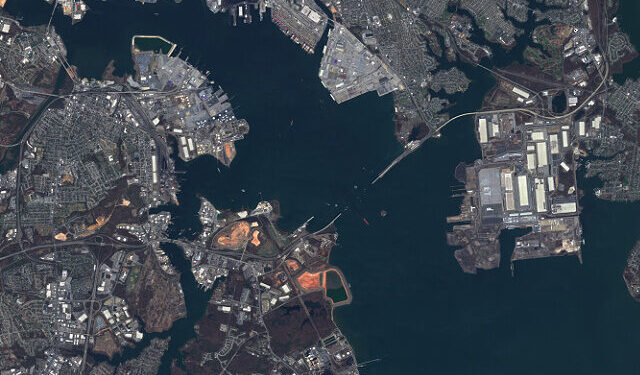A dramatic scene unfolded Monday evening in Baltimore Harbor, where a cargo ship fire in the Chesapeake Bay sent emergency crews rushing to contain the situation. “At this time, numerous emergency crews are responding to a cargo ship fire in the Baltimore Harbor on Chesapeake Bay, according to Maryland officials,” noted Rawsalerts. “The Baltimore City Fire Department reported that the ship caught fire in the Patapsco River near the site of the Key Bridge collapse.”
This was no ordinary fire. For residents in the area, it carried haunting echoes of the Francis Scott Key Bridge disaster just months ago, when Baltimore’s infrastructure and supply chain were thrown into chaos after the collapse. Adding another maritime emergency in the same waters only underscores how fragile critical infrastructure and commerce can be when accidents—or lapses in oversight—occur.
“While initial reports described it as an explosion, officials clarified that the incident involved an under-deck fire that sent smoke billowing into the air. The fire has since been contained, and the vessel is being removed from the channel. The cause of the fire remains under investigation,” it added.
Even with the fire contained, the bigger story here is what it reveals about vulnerabilities in America’s shipping routes and the ripple effects for families and businesses alike. Cargo ships like this aren’t just large vessels—they are floating supply chains, carrying goods that feed into everything from local groceries to global markets. A single fire can bring a busy harbor to a standstill, delaying shipments, driving up costs, and reminding us how interconnected our economy really is. For working families already stretched thin by inflation and rising taxes, disruptions like these only compound the burden.
Video captured the moment of the explosion and was widely shared on social media, reflecting the sheer scale of the incident. For Baltimore residents still recovering from the bridge collapse, it was a chilling reminder of how quickly life can be upended when disaster strikes in the nation’s ports.
According to Fox5DC, witness Jay Steinmetz said that “the name of the ship is the MV W Sapphire,” and VesselFinder described it as “a bulk carrier headed to Mauritius.”
That detail matters more than it may appear. With international shipping lanes linking America to far-flung destinations like Mauritius, every breakdown in maritime logistics highlights just how much we rely on a functioning, secure, and resilient port system. It also highlights why national security and strong leadership are essential in safeguarding trade routes and protecting against potential threats—whether natural, accidental, or man-made.
The fact that such incidents happen in a major American harbor raises important questions about oversight, accountability, and preparedness. It serves as a reminder that local communities often pay the price for bureaucratic mismanagement or underinvestment in infrastructure. Fires like this don’t just burn steel—they ignite broader debates about whether government is doing enough to ensure safety while not overburdening taxpayers with bloated regulations that fail to deliver results.
For now, the cause of the blaze remains unknown, and thankfully, the immediate danger has been contained. But the image of thick smoke rising above the Chesapeake Bay lingers, symbolizing the delicate balance between commerce, security, and government responsibility. America’s ports are the beating heart of our economy. If we don’t treat them with the seriousness they deserve, families, workers, and businesses alike will pay the price when the system falters.




















